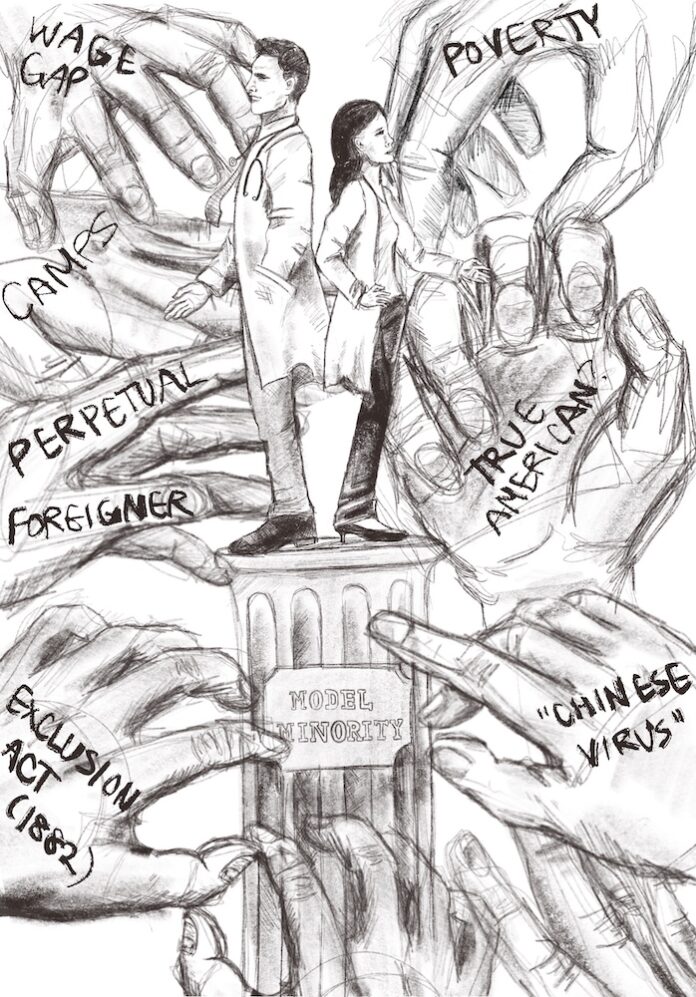I used to believe that Asian Americans were a model minority. I used to think that the stereotype of Asian Americans as smart, hardworking, studious and polite did no harm since these are desirable characteristics. As I grew older, I gradually realized this was not the case. Like all stereotypes, the stereotype of Asian Americans as a model minority lacks nuance and creates a false narrative of Asian Americans as a monolithic group.
My view of Asian Americans as the model minority was distorted by my experiences. Growing up in Honolulu, Hawaii, the county with the highest percentage of Asian Americans in the United States, I was surrounded by Asian Americans who worked hard and achieved success. Most of my friends in school were Asian Americans and many of them spent countless hours completing their homework, writing essays and studying for exams, leading to high grades and academic success.
My grandpa was the embodiment of a model minority citizen. He had grown up in Thailand to a poor family, worked extremely hard in school and was the first in his family to attend university. He then went to medical school in Thailand, eventually moving to the United States and becoming an OB-GYN.
My grandpa’s story is amazing and inspiring, but it is also an exception: 65 percent of children born to parents in the bottom 20 percent of the economic distribution remain in the bottom 40 percent when they grow older. Upward social mobility has been on the decline since the 1940s, and today, only half of children grow up to earn more than their parents. Despite this, rags-to-riches stories like his are commonly told, creating an overly optimistic view on social mobility.
The term “model minority” was coined in 1966 by sociologist William Peterson in a New York Times Magazine story entitled “Success Story: Japanese American Style.” The premise behind the article was that Japanese Americans should serve as models of success to other minority groups; if they were able to rise up after World War II internment camps, what was stopping others?
The narrative of Asian Americans as a model minority has continued and the implications of this myth and the stereotypes it creates hurt Asian Americans. Asian Americans’ perceived success leads to the belief that they do not experience racism and do not have needs that warrant societal and government policy concerns.
This narrative is not only false, it is dangerous. On March 16 in Atlanta, six women of Asian descent were among the eight people tragically murdered by a white man. The shooter was not “having a bad day.” This was a crime motivated by hate, racism and sexism. Sadly, this is not an isolated incident. Stop AAPI Hate has reported that there have been 3,795 anti-Asian hate crimes from roughly the start of the pandemic. Asian women have reported hate incidents 2.3 times more than men, showing the coalescence between racism and sexism, with the stereotype of Asian women as meek and submissive.
We cannot allow this pattern of anti-Asian violence, racism and sexism to continue.
Older Asian Americans have also been conditioned to tolerate racism and bigotry, according to comedian and host of the Netflix show “Patriot Act,” Hasan Minhaj.
“The ‘American dream tax’ is this concept I came up with where, I noticed that my dad, when he’d see either microaggressions or full-on aggression happening in America, he sort of considers that the cost of entry,” Minhaj has said. “So you’re going to endure racism or bigotry or microaggressions, and if it doesn’t kill you, then it’s worth it.”
Racism killed Soon Chung Park, Hyun Jung Grant, Suncha Kim, Yong Yue, Delaina Ashley Yaun, Paul Andre Michels, Xiaojie Tan and Daoyou Feng in Atlanta.
Racism killed Vicha Ratanapakdee, an 84-year-old Thai immigrant in San Francisco.
The unwillingness to speak up on social issues and simply accept the “American Dream Tax” has played into the model minority narrative, which has culminated in racism and hate against Asians being ignored or overlooked.
We must speak up against racism against Asian Americans. We must speak up against racism against all groups.
The model minority myth not only hurts Asian Americans; it also serves as a racial wedge between Asian Americans and other minority groups, particularly Black Americans. The comparisons between the two groups minimize the role that anti-blackness plays in the struggles of Black Americans. This creates the false narrative that if only other minorities worked harder, had stronger family ties and stopped fixating on the oppression they had previously faced, they too would achieve the same success.
The recent rise in anti-Asian hate and violence is a brutal reminder that no matter how hard Asian Americans work or how much success they achieve, Asian Americans are a minority group in a country built on white supremacy. Racism is complex and has systemic implications that can go unnoticed on the surface level. To truly enact change and achieve equality, we must reckon with this dark past and acknowledge the role it has played in creating systemic issues minority groups face.
Racism against Asian Americans has largely been ignored and excluded from the United States’ dominant culture. If you are looking for a place to start, reading these books will help you understand the history of anti-Asian racism in the United States and the impacts it has today. If possible, you can donate to groups like the National Asian Pacific American Women’s Forum (NAPAWF) and the “Support the AAPI Community Fund” on GoFundMe.
Individual actions are a great start but are too small to create broad-scale change. We must unlearn the model minority myth. We must establish solidarity between communities of color to fight the systems that continue to separate us from each other. We must understand the deep roots of racism in the United States and demand policies that will dismantle systemic oppression and bring about equity.
![]()




































